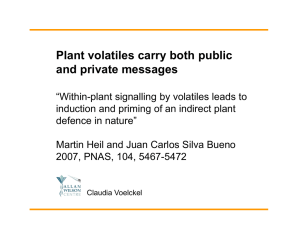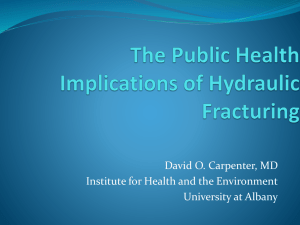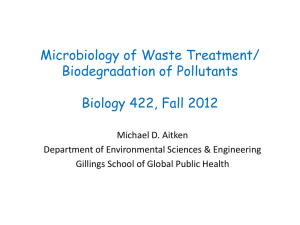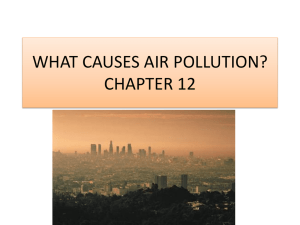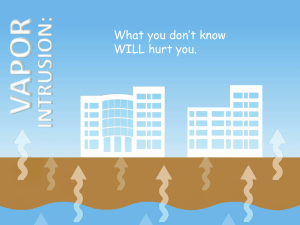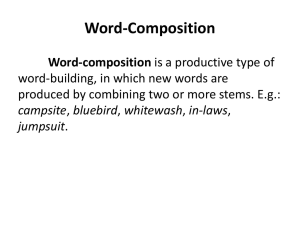United States - Global Ozone Project
advertisement
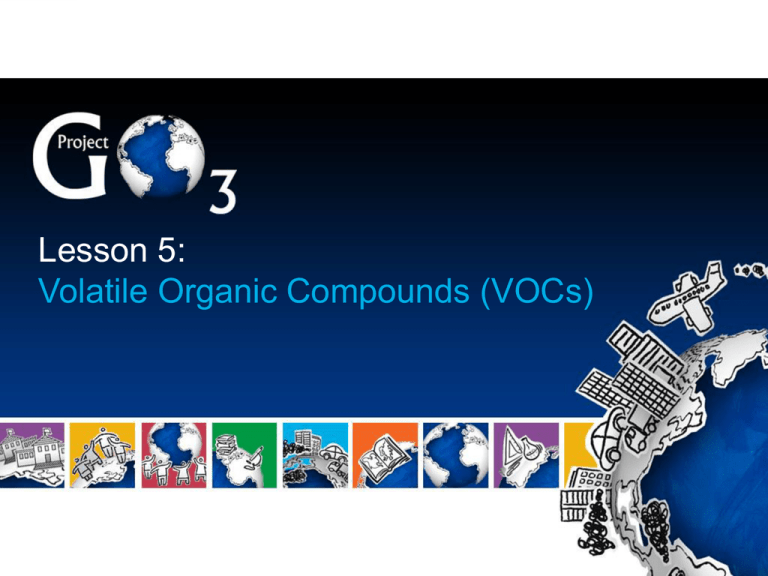
Lesson 5: Volatile Organic Compounds (VOCs) Learning Objectives At the end of this lesson students will be able to: • Identify three main examples of VOCs sources that lead to the formation of ground level ozone. • Understand the sources of VOCs globally that contribute to the formation of ground level ozone. • Identify examples of natural and anthropogenic sources of VOCs in the atmosphere. Lesson 3 : Carbon Sources - Carbon Monoxide A Closer Look at Another Carbon Source - VOCs We will look at: • VOCs’ role in ozone formation • Global anthropogenic and natural sources of VOCs VOCs (Volatile Organic Compounds) • A breakdown of anthropogenic sources of VOCs, globally and in the USA • Other interesting information about VOCs Lesson 5: Volatile Organic Compounds (VOCs) First of all, what are VOCs? VOCs are chemical compounds containing carbon that vaporize easily and enter the atmosphere. They can be released directly into the air, or by incomplete combustion in the burning of fossil fuels in automobile engines and power plants. Vapors from Paint Thinner Lesson 5: Volatile Organic Compounds (VOCs) Gasoline Vapors Vapor Video We can’t see many of the VOCs released into the atmosphere. This infrared video shows the vapors (VOCs) that are released when a gas tank is filled. Click on the image or on the link to watch the video: YouTube Vapor Video Lesson 5: Volatile Organic Compounds (VOCs) Series of Reactions with VOCs The series of reactions with VOCs that leads to the formation of ground level ozone is… well…a little bit complicated! Lesson 5: Volatile Organic Compounds (VOCs) Global Anthropogenic Sources of VOCs Lesson 5: Volatile Organic Compounds (VOCs) Breakdown of Global Anthropogenic Sources of VOCs How does this breakdown differ from the CO sources? What is the main source of anthropogenic VOCs? Waste Handling Agriculture 2% 1% Industrial Processes 16% Biofuel 18% Biomass Burning 14% Fossil Fuels* 49% *Includes automobile emissions Lesson 5: Volatile Organic Compounds (VOCs) Global Anthropogenic Non-Methane VOC (NMVOC*) Emissions Density *NMVOC = Non-Methane VOCs, which are VOCs excluding methane, which is discussed separately Legend NMVOC Total 2000 0 – 0.1 Gg NMVOC per cell 0.1 – 1 1–2 2 – 10 10 – 50 50 – 100 100 – 2,000 Gg NMVOC per cell Units = Gigagrams of NMVOC (1 Gigagram = 109 grams = 1,000,000,000 grams) Lesson 5: Volatile Organic Compounds Regional Breakdown of Total Global Anthropogenic NMVOC Emissions South East Asia 7% South Asia 7% Chart Title East Asia 8% Canada 6% USA 12% OECD Europe 10% Middle East 8% Africa 13% Latin America 10% Lesson 5: Volatile Organic Compounds (VOCs) Russia 11% Oceanica 2% Japan 4% Eastern Europe 2% Anthropogenic Sources of VOCs in the United States Lesson 5: Volatile Organic Compounds (VOCs) VOC Emission Inventory for the United States Emission Inventories are created to tally the amount of VOCs emitted by each region of the county, in this case by county. If you live in the US, what is your county's VOC Emission Density? Lesson 5: Volatile Organic Compounds Breakdown of Anthropogenic Sources of VOCs in the United States What are the top three sources of VOCs in the US? Lesson 5: Volatile Organic Compounds (VOCs) Natural Sources of VOCs Lesson 5: Volatile Organic Compounds (VOCs) There are Significant Natural Sources of VOCs Other 0.7% Biomass Burning 1.7% Biofuel Industrial Fossil Fuel 2.1% Processes 6.0% 1.9% Agriculture 0.2% Shrubs 14.8% Waste Handling 0.2% Crops 9.2% Trees 62.7% Lesson 5: Volatile Organic Compounds (VOCs) Oceans 0.4% What are the Natural Sources of VOCs? Trees emit VOCs in the form of isoprene and monoterpenes, which give them their characteristic smell. Trees emit VOCs for a variety of reasons: • To repel harmful insects and animals. • To attract pollinators. • As a stress response. Lesson 5: Volatile Organic Compounds (VOCs) Isoprene, one of the VOCs emitted by trees Kudzu – Another Natural Source of VOCs The invasive vine Kudzu produces isoprene, a “growing” problem for ozone formation in the Southeastern US Lesson 5: Volatile Organic Compounds (VOCs) If natural sources emit 88% of the world’s VOCs… Why should we be concerned with the amount we emit? Natural vs. Recall that trees are a huge source of VOCs. However, as the image above of the world’s forests reveals, these emissions are spread out over the entire earth. Lesson 5: Volatile Organic Compounds (VOCs) Anthropogenic Anthropogenic sources are much more concentrated than natural sources, resulting in concentrated “chemical soups” and unhealthy conditions. Atmospheric “Balance” The delicate balance of the compounds in the atmosphere developed over millions of years. Natural Anthropogenic There are two main reasons human activity is negatively affecting the environment: 1. Human activity can tip the delicate balance, causing pollutants to interact in different ways than they would naturally (we will look into this more in later slides). 2. The natural sources of the compounds cover the entire planet, in contrast with human pollution, which is extremely concentrated in small areas. Lesson 5: Volatile Organic Compounds (VOCs)
